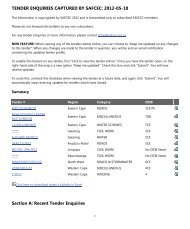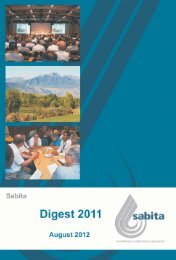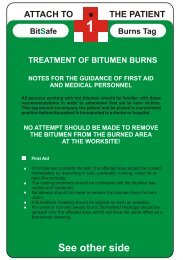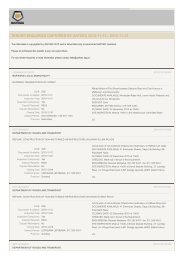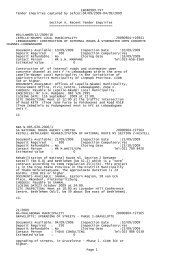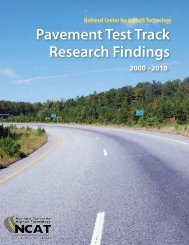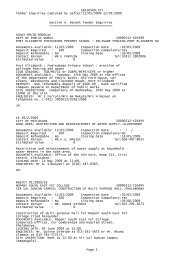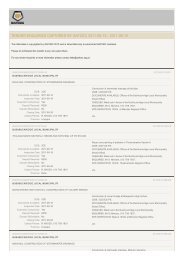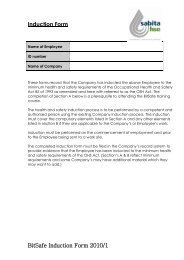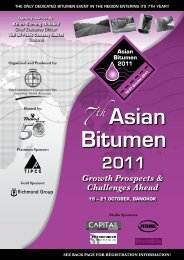DIGEST 2006 - Sabita
DIGEST 2006 - Sabita
DIGEST 2006 - Sabita
You also want an ePaper? Increase the reach of your titles
YUMPU automatically turns print PDFs into web optimized ePapers that Google loves.
The total analysis of the bitumens<br />
showed that they contained small<br />
amounts of volatile aromatic<br />
hydrocarbons, notably the BETX<br />
compounds and trimethylbenzene<br />
isomers, plus low amounts of<br />
polycyclic aromatic hydrocarbons<br />
(PAHs) such as naphthalene,<br />
anthracene, phenanthrene and<br />
pyrene: none of the PAHs<br />
observed are classified as known<br />
human or animal carcinogens.<br />
provided the estimated<br />
environmental concentration is<br />
less that the acceptable risk limit<br />
of the species, in this case Pb.<br />
Therefore, all the penetration<br />
grade bitumens delisted for<br />
disposal to general waste sites and<br />
can be disposed to medium or<br />
large general waste landfills that<br />
have a leachate management<br />
system, i.e. GMB+ or GLB+.<br />
Traces of chloroform, bromodichloromethane<br />
and phthalate<br />
esters were also detected in some<br />
of the samples. Although these<br />
organic species were identified in<br />
the bitumen samples, only toluene<br />
was detected in the leach solutions<br />
– but at trace levels close to the<br />
detection limit of 1ppb. There are,<br />
therefore, no<br />
organic compounds<br />
leached from the<br />
samples that can<br />
have a significant<br />
impact on the<br />
environment.<br />
Two samples of the<br />
penetration grade<br />
bitumen, B and D,<br />
leached Pb at<br />
concentrations just<br />
above its acceptable<br />
risk limit of 0.10<br />
mg/l and, therefore<br />
formally classify as<br />
high hazard (HG2) wastes in terms<br />
of the Minimum Requirements.<br />
Samples A and C formally<br />
classified as non-hazardous in<br />
terms of the Minimum<br />
Requirements. Even though a<br />
waste formally classifies as<br />
hazardous it can be delisted for<br />
disposal to a general waste landfill<br />
There are no<br />
organic<br />
compounds<br />
leached from<br />
the samples<br />
that can have<br />
a significant<br />
impact on the<br />
environment.<br />
Final report<br />
The final report produced early in<br />
2003 proposed that application be<br />
made to DWAF for approval of the<br />
delisting of penetration grade<br />
bitumens and that this include a<br />
request also for disposal to GBsites<br />
because GB+ landfills are not<br />
available in many<br />
areas within a<br />
reasonable<br />
transport distance.<br />
In their reply<br />
received on the 9th<br />
June 2004 DWAF<br />
gave permission for<br />
bitumen waste to<br />
be considered<br />
delisted subject to<br />
the conditions that<br />
if any uncertainty<br />
exists about<br />
whether a specific<br />
material falls within<br />
the tested parameters, then<br />
further analysis and leachate tests<br />
may be required. The delisted<br />
material may only be disposed of<br />
on a permitted facility, after the<br />
Permit Holder has applied and<br />
received written permission from<br />
DWAF.<br />
127



